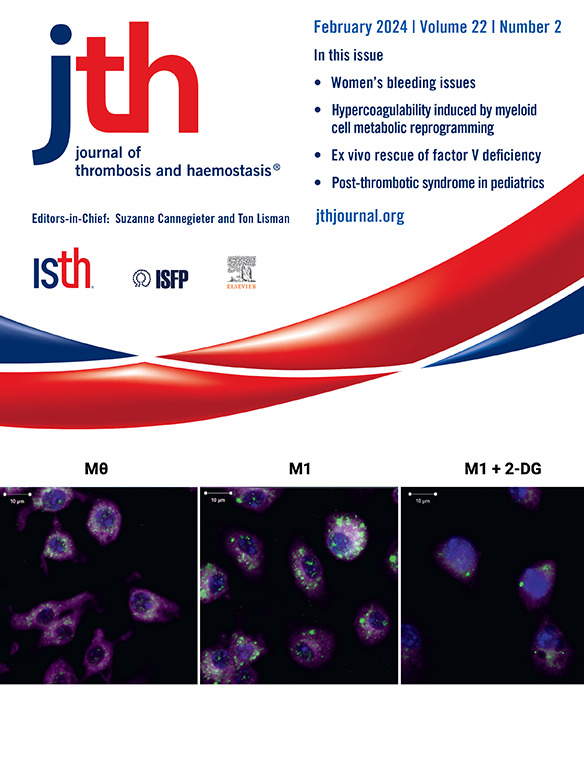罗沙司他治疗免疫性血小板减少症的潜力:孟德尔随机分析。
IF 5.5
2区 医学
Q1 HEMATOLOGY
引用次数: 0
摘要
背景:免疫性血小板减少症(ITP)以免疫介导的血小板破坏和巨核细胞成熟受损为特征。缺氧诱导因子-1α (HIF-1α)在巨核细胞的发育和免疫调节中起关键作用,在ITP中下调。罗沙司他稳定HIF-1α,已成为ITP的潜在治疗药物,通过增强HIF-1α介导的巨核细胞发育和调节免疫反应。目的:本研究采用孟德尔随机化(MR)分析评价罗昔他特治疗ITP的安全性和疗效。方法:我们使用来自开放全基因组关联研究(Open Genome-Wide Association Study, OpenGWAS)项目的罗沙司他靶基因EGLN1、EGLN2、EGLN3的表达数量性状位点(Quantitative Trait Loci, eQTLs)数据,分析其与ITP的遗传关联以及不良结局。MR分析包括IVW、MR- egger回归、加权中位数和MR多效性残差和异常值(MR- presso)方法来评估多效性。异质性评估采用Cochran’s Q统计量和I2测量,并进行敏感性分析。进行荟萃分析以整合来自多个文献来源的效应量。结果:MR分析显示罗沙司他与ITP风险降低之间存在显著相关性(优势比[OR] 0.79, 95%可信区间[CI] 0.66-0.95, P=0.01),无水平多效性证据。荟萃分析证实了洛沙司他对ITP的保护作用。利用罗沙司他靶基因EGLN1的eqtl作为工具变量,对39个潜在不良反应进行MR分析,结果显示没有显著增加,表明罗沙司他具有良好的安全性。结论:罗沙司他显示出对ITP的潜在保护作用,而不会增加不良后果的风险,表明其有望作为ITP的治疗选择,值得进一步研究。本文章由计算机程序翻译,如有差异,请以英文原文为准。
Therapeutic potential of roxadustat in immune thrombocytopenia: a Mendelian randomization analysis
Background
Immune thrombocytopenia (ITP) is characterized by immune-mediated platelet destruction and impaired megakaryocyte maturation. Hypoxia-inducible factor-1α (HIF-1α), pivotal in the development of megakaryocytes and immune regulation, is downregulated in ITP. Roxadustat, which stabilizes HIF-1α, has emerged as a potential therapeutic drug for ITP that acts by enhancing HIF-1α–mediated megakaryocyte development and modulating immune responses.
Objectives
This study evaluates the safety profile of roxadustat and its therapeutic efficacy for ITP treatment using Mendelian randomization (MR) analysis.
Methods
We used expression quantitative trait loci data for roxadustat’s target genes (EGLN1, EGLN2, and EGLN3) and genetic associations with ITP and adverse outcomes from the Open Genome-Wide Association Study project. MR analysis included inverse-variance weighted, MR-Egger regression, weighted median, and MR pleiotropy residual sum and outlier methods to evaluate pleiotropy. Heterogeneity was assessed using Cochran’s Q statistic and I2 measure with sensitivity analyses. A meta-analysis was performed to integrate effect sizes from multiple literature sources.
Results
MR analysis revealed a significant association between roxadustat and reduced ITP risk (odds ratio, 0.79; 95% CI, 0.66-0.95; P = .01) with no evidence of horizontal pleiotropy. Meta-analysis confirmed the protective effect of roxadustat on ITP. Utilizing the expression quantitative trait loci of roxadustat’s target gene EGLN1 as instrumental variables, an MR analysis of 39 potential adverse reactions revealed no significant increase, suggesting a favorable safety profile for roxadustat.
Conclusion
Roxadustat demonstrates a potential protective effect against ITP without increasing the risk of adverse outcomes, suggesting its promise as a therapeutic option for ITP and warranting further investigation.
求助全文
通过发布文献求助,成功后即可免费获取论文全文。
去求助
来源期刊
CiteScore
24.30
自引率
3.80%
发文量
321
审稿时长
1 months
期刊介绍:
The Journal of Thrombosis and Haemostasis (JTH) serves as the official journal of the International Society on Thrombosis and Haemostasis. It is dedicated to advancing science related to thrombosis, bleeding disorders, and vascular biology through the dissemination and exchange of information and ideas within the global research community.
Types of Publications:
The journal publishes a variety of content, including:
Original research reports
State-of-the-art reviews
Brief reports
Case reports
Invited commentaries on publications in the Journal
Forum articles
Correspondence
Announcements
Scope of Contributions:
Editors invite contributions from both fundamental and clinical domains. These include:
Basic manuscripts on blood coagulation and fibrinolysis
Studies on proteins and reactions related to thrombosis and haemostasis
Research on blood platelets and their interactions with other biological systems, such as the vessel wall, blood cells, and invading organisms
Clinical manuscripts covering various topics including venous thrombosis, arterial disease, hemophilia, bleeding disorders, and platelet diseases
Clinical manuscripts may encompass etiology, diagnostics, prognosis, prevention, and treatment strategies.

 求助内容:
求助内容: 应助结果提醒方式:
应助结果提醒方式:


